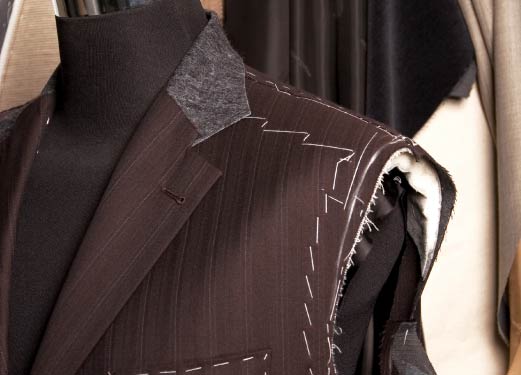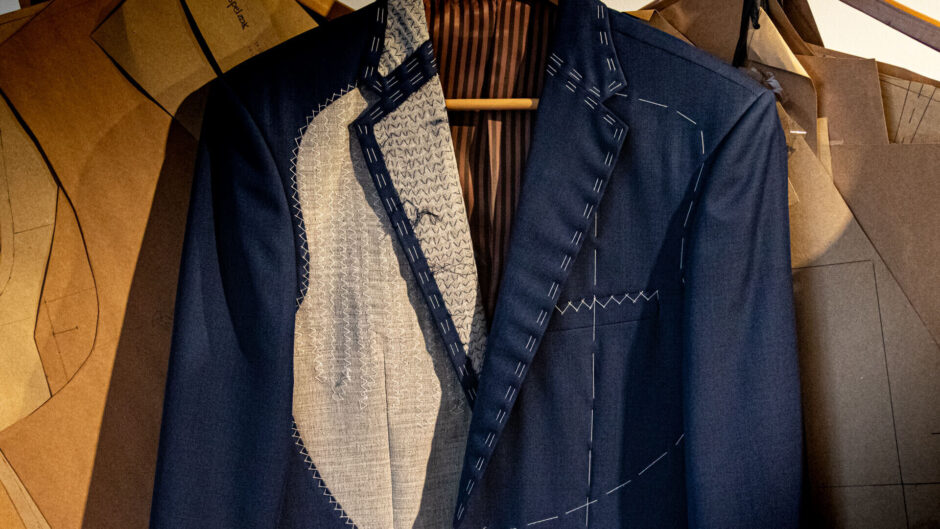Luxury fashion has long been associated with opulence, extravagance, and indulgence. However, in recent years, there has been a notable shift in consumer preferences towards more sustainable and eco-friendly options. This trend has extended to the realm of suit making, where traditional craftsmanship is now being combined with innovative practices to create garments that not only exude elegance but also minimize environmental impact. If you’re interested in sustainable fashion, exploring how eco-friendly principles extend beyond suits to include men’s athletic shorts highlights the growing importance of environmental considerations in the apparel industry.
The adoption of sustainable practices in suit making begins with the sourcing of materials. Unlike conventional methods that rely heavily on synthetic fabrics and chemical dyes, eco-friendly suit makers prioritize natural, organic materials such as organic cotton, hemp, and linen. These materials are not only renewable but also biodegradable, reducing the carbon footprint of the manufacturing process. Additionally, many sustainable suit makers opt for plant-based dyes or non-toxic alternatives to minimize water pollution and harm to ecosystems.
In addition to sustainable materials, ethical labor practices are a cornerstone of eco-friendly suit making. With increased scrutiny on supply chain transparency, consumers are demanding greater accountability from fashion brands. Sustainable suit makers prioritize fair wages, safe working conditions, and respect for workers’ rights throughout the production process. By supporting ethical labor practices, consumers can feel confident that their purchase aligns with their values and contributes to positive social impact.
Similar to how fashion designers embrace eco-friendly materials, marriage officiants are adapting their practices to cater to couples who prioritize sustainability in all aspects of their wedding planning.
Innovative Techniques and Technologies

The rise of sustainable luxury in suit making has also spurred innovation in techniques and technologies. Traditional tailoring methods are being complemented by cutting-edge advancements that reduce waste and optimize resource utilization. One such innovation is the use of 3D body scanning technology to create custom-fit suits with minimal fabric waste. By precisely mapping the contours of the wearer’s body, tailors can create garments that not only fit perfectly but also minimize the need for alterations, further reducing waste.
Furthermore, advancements in textile recycling are revolutionizing the way suits are made. Instead of relying solely on virgin materials, sustainable suit makers are increasingly incorporating recycled fabrics into their collections. These recycled materials are sourced from a variety of post-consumer and post-industrial sources, including plastic bottles, discarded clothing, and textile waste. By giving new life to old materials, sustainable suit makers are diverting waste from landfills and reducing the demand for raw materials, thereby conserving natural resources.
Much like how sustainable luxury brands strive to minimize their environmental footprint, dog grooming in Seattle demonstrates a commitment to using products and practices that are gentle on the planet, highlighting the interconnectedness of eco-conscious efforts across various industries.
Another innovative technique gaining traction in sustainable suit making is zero-waste pattern cutting. Traditional pattern cutting methods often result in leftover fabric scraps that are discarded as waste. However, zero-waste pattern cutting aims to utilize every inch of fabric, minimizing waste and maximizing efficiency. By strategically arranging pattern pieces and employing innovative cutting techniques, tailors can create garments with minimal leftover fabric, reducing the environmental impact of production.
A Paradigm Shift in Consumer Behavior
The rise of sustainable luxury in suit making reflects a broader shift in consumer behavior towards more conscious consumption. Increasingly, consumers are prioritizing quality over quantity and seeking out brands that align with their values of sustainability and social responsibility. This shift is driven by a growing awareness of the environmental and social impacts of fashion, as well as a desire to support brands that are working towards positive change.
Did you know that orthopedic physical therapy in Chicago can be instrumental in ensuring the longevity of skilled artisans in the suit-making trade? By incorporating regular physical therapy sessions into their routines, craftsmen can mitigate the strain associated with long hours of intricate work, allowing them to continue producing high-quality garments sustainably.
Furthermore, the rise of social media and digital platforms has empowered consumers to research and advocate for sustainable fashion choices. Influencers and activists play a crucial role in raising awareness about ethical and sustainable practices within the fashion industry, prompting brands to respond to consumer demand for transparency and accountability. As a result, sustainable suit makers are gaining traction in the market, attracting a new generation of conscious consumers who are willing to invest in high-quality, eco-friendly garments.
The Power of Collaboration: Industry Partnerships
A significant driver behind the rise of sustainable luxury in suit-making lies in the power of collaboration among industry stakeholders. Fashion brands, textile manufacturers, and environmental organizations are increasingly joining forces to develop innovative solutions that prioritize sustainability without compromising on quality or style. These collaborations leverage the expertise and resources of multiple partners to address complex challenges and drive positive change throughout the supply chain.
While luxury suit makers source eco-friendly materials for their garments, they also ensure that waste generated during production is handled responsibly through partnerships with local dumpster rental companies, such as dumpster rental in Niceville.

One example of such collaboration is the partnership between luxury fashion houses and sustainable textile producers. By working together, these partners can co-create fabrics that meet the stringent standards of luxury fashion while also adhering to sustainability principles. Through joint research and development efforts, they can explore new materials and manufacturing techniques that reduce environmental impact without sacrificing performance or aesthetics. This collaborative approach not only benefits individual brands but also contributes to the overall advancement of sustainable practices within the industry.
Furthermore, collaborations between fashion brands and environmental organizations play a crucial role in raising awareness and driving systemic change. Through initiatives such as sustainable fashion campaigns and industry roundtables, these partnerships educate consumers and industry stakeholders about the importance of sustainability in fashion and advocate for policy reforms that support environmentally responsible practices. By amplifying their voices and pooling their resources, these partners can influence industry norms and promote the adoption of more sustainable business models.
Commercial pest control in Reno is undergoing a transformation towards more eco-conscious practices, mirroring the shift towards sustainability in luxury fashion.
The Rise of Circular Fashion: Closing the Loop
In recent years, there has been a growing interest in circular fashion – a concept that seeks to create clothing cycles that are regenerative and waste-free. Unlike the traditional linear model of fashion production, which follows a ‘take-make-dispose’ approach, circular fashion aims to minimize waste and maximize resource efficiency by keeping products and materials in use for as long as possible. This shift towards circularity is driving innovation across the fashion industry, including in the realm of suit making.
One key aspect of circular fashion is the emphasis on durability and longevity. Sustainable suit makers are designing garments with timeless styles and high-quality construction that can withstand the test of time. By investing in pieces that are built to last, consumers can reduce their overall environmental footprint and minimize the need for frequent replacements. Additionally, some brands offer repair and alteration services to extend the lifespan of their products, further contributing to a circular economy.
Did you know that many high-end lingerie brands now prioritize using organic and ethically sourced materials in their designs? By incorporating sustainable materials and production methods, these brands align with the growing demand for eco-conscious fashion choices among consumers.
Another aspect of circular fashion is the adoption of closed-loop production systems. Instead of relying solely on virgin materials, sustainable suit makers are exploring opportunities to incorporate recycled and upcycled materials into their collections. By closing the loop and reintroducing materials back into the production cycle, these brands can reduce reliance on finite resources and minimize waste. Additionally, advancements in recycling technologies are making it possible to transform old garments and textile waste into new yarns and fabrics, further supporting the transition to a circular fashion system.
Consumer Education and Empowerment
Central to the success of the sustainable luxury movement in suit making is the role of consumer education and empowerment. As consumers become more informed about the environmental and social impacts of their purchasing decisions, they are increasingly demanding transparency and accountability from fashion brands. Sustainable suit makers are responding by providing consumers with information about their sourcing, production processes, and environmental initiatives, empowering them to make more conscious choices.
Educational initiatives such as workshops, seminars, and online resources play a crucial role in raising awareness about sustainable fashion practices. By providing consumers with insights into the lifecycle of clothing and the environmental consequences of fast fashion, these initiatives empower them to make informed decisions and adopt more sustainable consumption habits. Additionally, fashion brands are leveraging social media and digital platforms to engage with consumers and share stories about their sustainability journey, fostering a sense of connection and community around shared values.
While sustainable materials and ethical production processes are becoming integral to luxury brands’ identities, M&A services play a crucial role in facilitating strategic collaborations and acquisitions.

Furthermore, consumer empowerment extends beyond education to include advocacy and activism. By voicing their concerns and preferences, consumers can influence industry practices and hold brands accountable for their actions. Social media campaigns, petitions, and boycotts are powerful tools for driving change and encouraging brands to prioritize sustainability and ethics. As consumers increasingly demand transparency and accountability from fashion brands, the industry is being forced to confront its environmental and social impact and adopt more responsible practices.
Investing in Innovation: Future Trends
Looking ahead, the future of sustainable luxury in suit making is ripe with opportunities for innovation and growth. As consumer demand for eco-friendly fashion continues to rise, brands are investing in research and development to stay ahead of the curve and differentiate themselves in the market. From experimenting with alternative materials to embracing cutting-edge technologies, sustainable suit makers are pushing the boundaries of traditional fashion norms and paving the way for a more sustainable and inclusive industry.
Did you know that sustainable luxury isn’t limited to fashion but also extends to the services we use, such as limo rental in Denver? Opting for eco-friendly transportation not only adds a touch of luxury to special events but also reduces carbon emissions, making it a stylish and environmentally responsible choice.
One emerging trend in sustainable luxury is the integration of biotechnology and biofabrication into the design process. Researchers and designers are exploring the use of microbial fermentation, bioengineering, and other biotechnological processes to create innovative materials that are both sustainable and high-performing. These bio-based materials offer exciting possibilities for the future of fashion, including garments that are biodegradable, compostable, and even self-repairing. By harnessing the power of nature, sustainable suit makers can reduce their reliance on conventional materials and minimize environmental impact.
Another trend shaping the future of sustainable luxury is the rise of rental and resale platforms. Instead of purchasing clothing outright, consumers can now access designer suits and other luxury items through rental services and peer-to-peer resale platforms. This shift towards a more circular and sharing-based economy not only extends the lifespan of garments but also reduces the overall demand for new production. By embracing rental and resale models, consumers can enjoy the benefits of luxury fashion without the environmental and financial costs associated with ownership.
An expert construction plumber in Deerfield Beach remarks that he loves wearing sustainable luxury clothing brands because they reflect his commitment to environmental responsibility and quality craftsmanship.
In conclusion, the rise of sustainable luxury in suit making represents a transformative shift in the fashion industry towards more ethical, environmentally conscious, and inclusive practices. By prioritizing sustainability, innovation, and consumer empowerment, sustainable suit makers are redefining the standards of luxury and paving the way for a more sustainable and equitable future. As the movement continues to gain momentum, the possibilities for innovation and positive change are limitless, offering hope for a more sustainable and regenerative fashion industry for generations to come.

